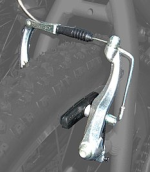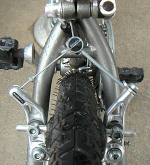ebike4healthandfitness
10 kW
- Joined
- May 19, 2012
- Messages
- 810
Leaf Bike informed me the 35mm motor uses N38H magnets. The "H" rating indicates no irreversible magnetism loss up to a temp of 120C.
That's what I do, to good effect. Two 48V common-port batteries wired in parallel.
What diameter tire are you running?Nice, do you use specifically paired and balanced batteries? I have one 15ah battery which has terrible sag, and a 17.5ah. So it could be risky running them down to lower voltage.
I thought this would combine the amps of two batteries, but not sure. It automatically shuts one battery off if it goes to a low voltage. 24V/36V/48V/52V/60V/72V Dual Battery Connector / Splitter Micro Anderson
Does anyone run packs in series for double the voltage?, eg. 2x36v for 72v or 2x48v?
Two identical (used) battery packs. I did not test them for determining any capacity differences. I simply charged the lower SOC one to within 0.1V of the higher SOC one before paralleling them together. They have stayed connected over hundreds of charge/discharge cycles over the past few years. Starting to get a little tired so probably will swap them out for the next set before winter.Nice, do you use specifically paired and balanced batteries?
What I think happens is the stronger battery ends up doing most of the work. Hopefully someone will correct me if that is incorrect. Are yours both common-port BMS?I have one 15ah battery which has terrible sag, and a 17.5ah. So it could be risky running them down to lower voltage.
Even if the packs were exactly the same, you still need to monitor the voltage level of each independently, as well as the total. In your case, it's even more important, because one of your packs is a piece of crap (paraphrasing), and since it's also the small one, it will sag into the danger zone quickly.Nice, do you use specifically paired and balanced batteries? I have one 15ah battery which has terrible sag, and a 17.5ah. So it could be risky running them down to lower voltage.
Leaf Bike informed me the 35mm motor uses N38H magnets. The "H" rating indicates no irreversible magnetism loss up to a temp of 120C.
I am keeping an eye out for a steel Mongoose or Schwinn mountain bike frame with disc brakes and 26" wheels.I feel like you're cutting it too low, don't have any 26er frames lying around?
Same here except finding bikes with disc brakes is pretty challenging. I can swap forks to get a disc on the front but I'd prefer to have the brackets for the rear caliper come on the bike from the factory.I don't know where you live ( location not entered ), but thrift stores are bursting with 26" steel hardtail frames in my locale.
Full suspension? not so much.
This is a very short list, especially when you add the other criteria of non-thru axle dropouts. The window between when discs became more standardized, and when the industry moved to aluminum and 1 1/8” steerer tubes, and then went to thru axles, is relatively narrow.Surfing through Facebook Marketplace this morning for a steel framed bike with disc brakes and a threadless fork.
Not when it is wet. The coefficient of friction between steel or aluminum and wet rubber is somewhere close to ZEROThe only reason you would need disc brakes is because you're using an unintended wheel size. If you're using 26" wheels on a 26" frame, you don't have that problem and you can use rim brakes. Then you can have the benefits of simple, quiet, easily serviceable, lightweight, effective, and inexpensive brakes. And it makes it much easier to get a frame that checks all your other boxes.
Pound for pound and dollar for dollar, a 22" rotor beats a 6" rotor every time.
Adding battery capacity adds range without breaking stuff or adding points of failure.As a result of using the single lever, ~90% of my braking is regenerative braking. This optimizes my range.
Sounds like you haven't tried it. Or at least not tried Kool Stop Salmon pads on brakes that are competently set up.Not when it is wet. The coefficient of friction between steel or aluminum and wet rubber is somewhere close to ZERO.
I agree the list is pretty short.This is a very short list, especially when you add the other criteria of non-thru axle dropouts. The window between when discs became more standardized, and when the industry moved to aluminum and 1 1/8” steerer tubes, and then went to thru axles, is relatively narrow.
I was keeping a list for a while, but the couple of bikes I found were out of Canada for some reason (but I did see one pop up on Craigslist once). I believe I saw a recent build with a steel frame and discs recently, but forgot to bookmark it. May have been a fat frame though.
Most current models, unless it’s a custom build, won’t have the right dropouts though. Marin makes steel frames with disc mounts but with thru axles for example. You may be able to find a list already compiled online since it seems to be a frequently asked question.
PS. Around here I see at least two ads posted regularly on Craigslist offering braze on disc brake conversions for steel frames. Never looked into the cost.
I have not tried the Salmon pads...I may have to do it now that I am aware of themSounds like you haven't tried it. Or at least not tried Kool Stop Salmon pads on brakes that are competently set up.
Discs get wet too, and they suck and honk when they do.
Surly TrollI agree the list is pretty short.
My list of requirements for a donor bike is below:
A. Disc brakes front and rear. I appreciate them when a clueless car driver pulls out in front of me when I am doing 45 mph. I prefer hydraulic calipers but the cable operated calipers work OK if you keep them adjusted correctly.
B. Enough clearance in the frame so I can run whatever width tire I like...usually that is a 2.6"-2.8" so "most" mountain bike frames will work.
C. A steel frame would be my first choice but aluminum is acceptable most of the time. I have had good luck with the Schwinn and Mongoose aluminum frames I have used...they appear to use a healthy safety factor in their design.
D. Enough room in the forward frame triangle that I can mount my triangle battery/battery bag. This usually means no rear suspension.
E. A threadless fork steerer. Makes using a "good" fork a relatively simple swap. I like the SR Suntour Raidon...it is a pretty good bang for your buck.
I agree the list is pretty short.
My list of requirements for a donor bike is below:
A. Disc brakes front and rear. I appreciate them when a clueless car driver pulls out in front of me when I am doing 45 mph. I prefer hydraulic calipers but the cable operated calipers work OK if you keep them adjusted correctly.
B. Enough clearance in the frame so I can run whatever width tire I like...usually that is a 2.6"-2.8" so "most" mountain bike frames will work.
C. A steel frame would be my first choice but aluminum is acceptable most of the time. I have had good luck with the Schwinn and Mongoose aluminum frames I have used...they appear to use a healthy safety factor in their design.
D. Enough room in the forward frame triangle that I can mount my triangle battery/battery bag. This usually means no rear suspension.
E. A threadless fork steerer. Makes using a "good" fork a relatively simple swap. I like the SR Suntour Raidon...it is a pretty good bang for your buck.
Are you planning on making this a mullet bike? (i.e. 26" diameter front tire coupled to 24" diameter rear tire)Bike is handling nicely now...it is going to be interesting to see how/if the handling changes when I go to a 24" rear wheel and a Schwalbe Pick-Up in size 24x2.6". My current 26" rear tire has an OD of 686mm and the 24" has an OD of 637mm...the original 29er has a 754mm OD.
It might unintentionally end up as a Mullet bike but only because the 24" rear wheel is a requirement to help with over heating and a 26" front tire handles better...but that is TBD. I have compared the handling of a 20" front wheel to a 26" and I liked the 26" better because the 20" wheel was a little twitchy but I have never directly compared a 24" to a 26"...yet.Are you planning on making this a mullet bike? (i.e. 26" diameter front tire coupled to 24" diameter rear tire)


